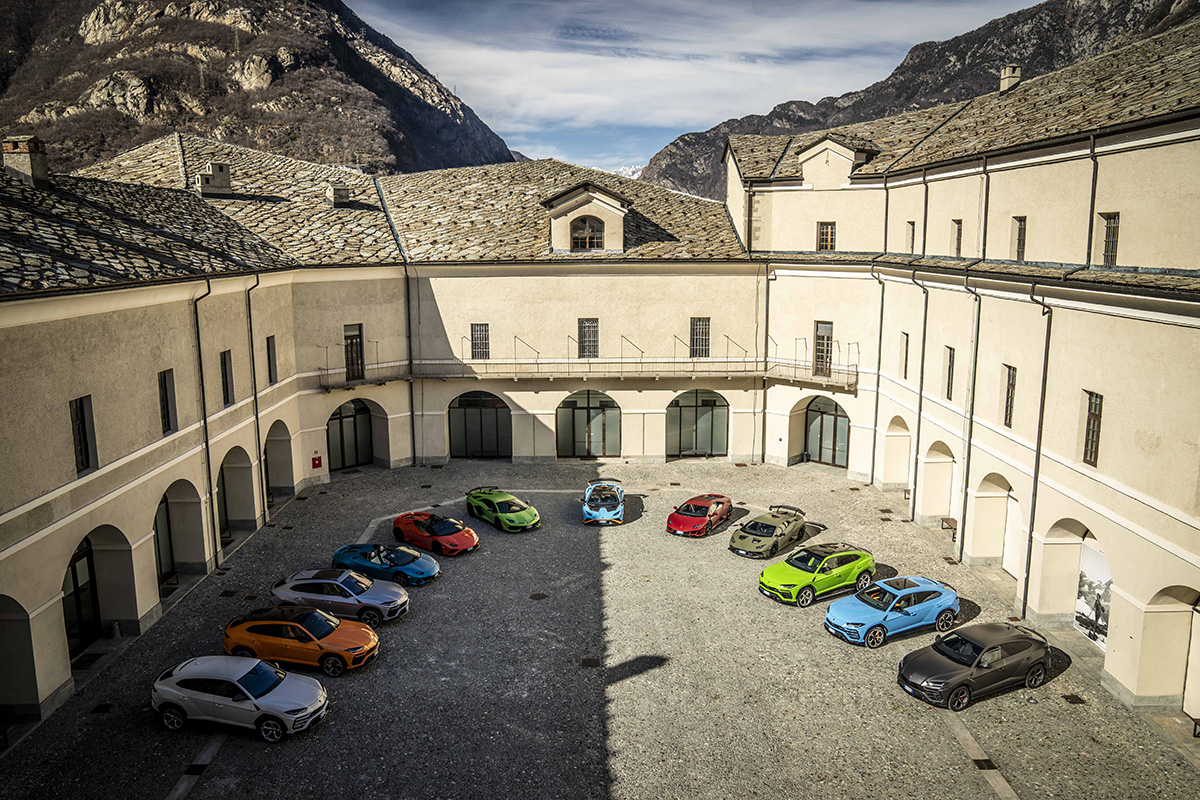
Our fleet at the foot of the Cervino (Matterhorn) in Cervina, Italy
You might associate Lamborghinis with Dubai, Cannes, Los Angeles and London, shooting down city streets or parked outside expensive restaurants and hotels. Candice Tucker visits Sant’Agata Bolognese, Italy, the home of the brand, and drives, and is driven in, the company’s latest models to a village high in the Alps
Like many, I find I can be easily distracted by a Lamborghini’s sleek shape, often ostentatious colours (most famously green, yellow and orange) and of course, the sound the engine makes when someone speeds past you.
Visiting the factory, watching the cars being made, altered my perception of the brand.

Making our way up into the Alps in convoy
Take a quick tour around the factory, in central Italy, and you can begin to see why these cars are some of the most expensive in the world. There are rows of stations, and clocks on each row that don’t say the time, but the amount of minutes each worker has left to work on their station. 33 minutes. That’s how long each worker in the main Urus factory has to do their part in the making of each Lamborghini. From the door fitters to the needle workers on the leather seats, everyone is under a timer to move their part onto the next station. The robots are only used to assist rather than replace the human hand. Your green status symbol is indeed hand made.
Follow LUX on Instagram: luxthemagazine

The Lamborghini factory has been CO2 neutral since 2015
The future is electric cars, and it’s difficult to imagine what this means for Lamborghini’s distinct sounding engines, but this hasn’t stopped them pursuing a hybrid transition with gusto. They expect by 2023 to create their first hybrid series production car and by the second half of the decade, Lamborghini has committed to creating a fully electric model.

The Lamborghini V12 is the brand’s flagship engine
After the factory came the journey, in various Lamborghinis. I started mine in the ‘beast’, also known as the ‘Urus’. Lamborghini’s SUV (large 4×4) is huge and extremely powerful. Driving it, you feel as if you are in the emperor of SUVs. Very big, very fast, and you can alter driving modes like in a supercar. “Corsa” mode felt wicked – Corsa means race in Italian.

Lamborghini makes a full-on supercar, the Aventador; a more practical two-seater sports car, the Huracán; and a powerful SUV, the Urus. All are available in a variety of specifications – and colours
If you want to take a step further into raciness mode, the Huracán STO or the SVJ Aventador might interest you. The Aventador is futuristic and showy from the outside. Inside, the SVJ is stripped of all its finer comforts, and you sit in unforgiving carbon fibre seats. It’s all about speed, which is no surprise given it is renowned V12 engine, which was deafening particularly when you drive through tunnels, the sound drilling through your ears. The STO is slightly lighter to drive and the exterior of the car is as close as you’ll get to looking like a race car on the road. Both cars offer the same extreme performance, but the STO allows you to remain cocooned in luxury by comparison.

The Urus was the most sold Lamborghini model in 2021, with 5,021 deliveries
Having travelled across the motorway, through the ancient part of the village of Bard in the Aosta valley (where cars are normally prohibited) and up the mountains to Cervinia, Lamborghini demonstrate that their cars are fit for purpose on any terrain. Whilst I wouldn’t suggest driving on icy roads, we put the STO and the Huracán EVO to the test, driving on an ice ring. The STO being a rear wheel drive, made this slightly more difficult to manoeuvre, but the EVO retained its speed and control.

Huracán EVO spinning on the ice track
The ultimate experience for me was the Huracán EVO Spyder. This is a convertible 640 horsepower supercar. Scaling the Italian Alps with the roof down, enjoying the fresh mountain air casting over your face was fun. With no space for a suitcase or even a hand luggage, the EVO wouldn’t be the car for your family ski holiday but it’s perfect for a day trip. The lightness of the car made it very agile up the mountain.
Read more: A tasting of Dalla Valle wines with the owners

Driving through the streets of the village of Bard, in the Aosta valley, where cars are usually prohibited. You can see why
There were no other Lamborghinis of any colour in Cervinia. It’s not that kind of place. It’s all about cows, mountain air, and the shadow of the Matterhorn. But what an adventure getting there in four of the most exciting and eye-catching cars in the world.
Find out more: lamborghini.com







Recent Comments